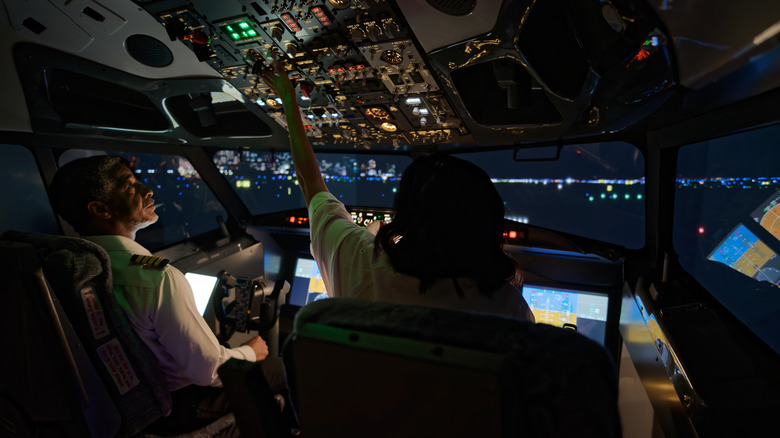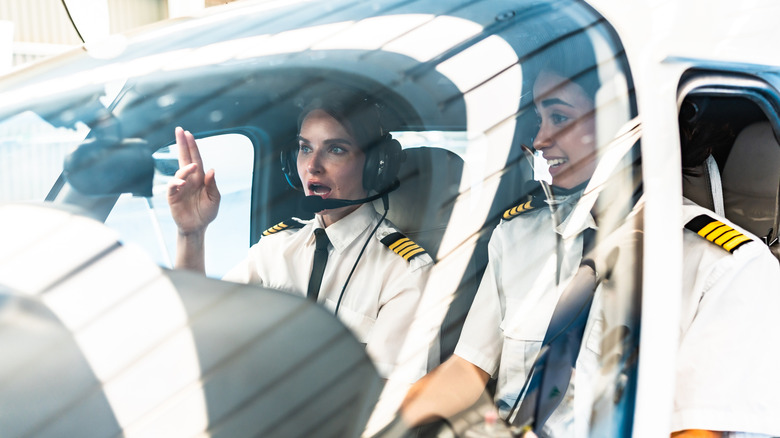Private Jet Pilots Are Different From Commercial Pilots - Here's How
Specialization has long been important in the field of aviation, particularly when it comes to how aircraft are used. For example, although helicopters like the Apache and UH-60 Black Hawk are both military machines, the Apache is an attack craft while the Black Hawk is a multi-purpose support vehicle. In this same vein, although the AS365 Dauphin and Leonardo AW139 are among the fastest civilian helicopters, the Dauphin is used mainly for Coast Guard rescue missions while the larger, slower Leonardo can be adapted to search and rescue, commercial, or other uses.
This level of specialization extends to planes, which range from small propeller-driven crop dusters to jumbo jets that carry hundreds of passengers. As for the pilots that operate these aircraft, their training and work routines are critical to being able to fly safely. Pilots of private and commercial planes may look more or less the same to outsiders, but the commonalities between the two are outnumbered by some key differences in the ways they learn and work.
Only licensed commercial pilots can be paid to fly
The main distinction is that only licensed commercial pilots are able to accept compensation for flying a plane; for that they go through a more rigorous certification process than recreational pilots. The exact procedure differs depending on the type of aircraft you want to operate, and according to the Federal Aviation Administration website, "If you are interested in flying ultralight vehicles, you don't need a pilot's license." All pilots must pass a medical evaluation and obtain a student certificate before flying solo. Training for a private pilot's license can be completed in about 40 hours, while commercial pilots must accumulate at least 250 flight hours in addition to first officer, instrument navigation, and TAA (Technically Advanced Airplane) training.
There are several levels of certification in between the PPL (Private Pilot's License) and the top-level ATPL (Airline Transport Pilot License), with various restrictions and privileges to each. If you want to fly your own private plane, you'll only need to earn a PPL. Earning a CPL (Commercial Pilot's License) requires English proficiency, 40 hours of ground school followed by a written exam, and at least 250 hours of flight time after that. Some of those 250 hours must be dedicated to instrument, cross-country, and solo flying. Once these minimums are met, there's a two-hour oral exam followed by another test in the cockpit. Recreational pilots can only carry one other passenger and must cover at least half of all flight costs; they may serve as the captain of an aircraft as long as it's within 50 miles of the originating airport, and for longer distances if other conditions are met. The ATPL requires at least 1,500 hours of flight time, which can be accumulated while familiarizing oneself with different aircraft.
Some commercially licensed pilots still fly private jets
CPL holders can train and qualify for the CMEL (Commercial Multi-Engine Land) license, which puts them one large step closer to a job with an airline. The restriction on compensation for flying a plane means that at times CPL holders are at the controls of private planes and getting paid for their work. You'll also need this additional training and certification to give tours or flying lessons. While many commercial pilots get certified on the largest jets in the world and eventually work for airlines, some spend their whole career giving lessons or flying the private planes of wealthy clients like Taylor Swift's $40 million Dassault Falcon. All pilots can earn ratings allowing them to fly certain planes and under progressively more complicated circumstances, and commercial pilots undergo extensive simulator training for a specific model of aircraft that is often sponsored by a prospective employer. There are also major differences with respect to how pilots of private and commercial planes handle flight duties. Private jet pilots will have irregular work schedules which can change last-minute at the whims of busy clients, and may even be hired on an "on-call" basis.
Commercial airline pilots work more regular hours and according to established flight schedules. Given the difference in the number of passengers carried on each flight, private plane pilots will often have a more personal relationship with their passengers than airline pilots. Salaries for both categories of pilot depend on the employer, with some private plane pilots earning as much as $300,000 annually. Commercially licensed charter pilots can easily earn five figures a month, while many pilots for major airlines or cargo carriers make more than $200,000 a year. These jobs require a proven record of safe flying, a more rigorous medical exam, and an ATPL certification.


